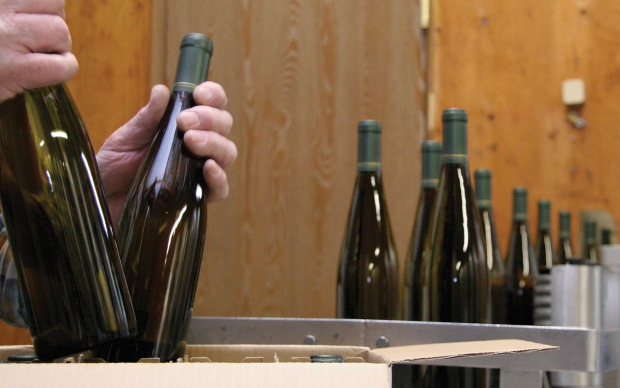
(Melissa Hansen/Good Fruit Grower file photo)
Positive sales trends continue for Washington’s wine industry, say wine executives from two of Washington’s largest wine producers. Washington wine sales have posted consistent growth for the past two years.
Martin Johnson of Ste. Michelle Wine Estates and Erik Hoins of Hogue Cellars gave insight into Washington wine sales during a panel discussion that was part of an annual grower caucus hosted by the Washington Association of Wine Grape Growers at Grandview in December.
Johnson called 2014 “an ideal year in the marketplace,” as he pointed out consistent growth over the past two years.
“The wine business is growing,” he said. “That’s really good news.”
Most varietals are growing, with the exception of a few that are of interest to Washington growers.
Syrah is down (-14.2 percent in the 52 weeks leading up to October 11), he said, as are Merlot and Riesling (-3.6 percent and -2.4 percent, respectively) — though he added that he is still happy with Syrah. It is used in red blends, a popular wine category that has grown.
Over the past year, he said, Cabernet Sauvignon has remained the “gold standard” of the industry. Making up 15.9 percent of industry sales, second only to Chardonnay, Cabernet has grown by 8.1 percent.
By comparison, Chardonnay sales grew by 1.7 percent .
“Chardonnay doesn’t have the premium energy that cabernet has,” Johnson said. “There’s a whole lot of $10 Chardonnay out there. There’s a big glut of it and the category is not very exciting.”
Premium playground
Growth is in premium wines, those wines that are over $7 per bottle, said Johnson. This is good for Washington because the state deals mostly in wines that are well above this price.
The greatest growth, according to Johnson, is in wines between $10 and $15. This category grew by 11.5 percent in the past year, while sales of wines under $7 declined. During this period, wines from $7 to $10 grew 1.4 percent, and wines $15 and above grew 10.6 percent.
“Fifteen dollars is the new playground,” he said. Long gone are the days of the $10 barrier. “The world is going premium,” according to Johnson. He sees this same trend toward premium in spirits and craft beers, and he believes that the trend will continue and that it will be good for growers.
“Premium is in very good shape,” he said. “I wouldn’t want to be in the sub-premium part of the business right now.”
With this in mind, Johnson said growers need to focus on quality. Today’s consumers are savvy—they frequently access the Internet while purchasing wine and make informed decisions.
Quality is especially important because there is an increase in the number of wines over $10, he added. Producers, then, need to distinguish their product over their competitors.
“These are facts,” said Hogue Cellars’ Hoins, confirming Johnson’s assessment of the market. “I see the same numbers.”
Hoins said an important takeaway from Johnson’s report is that low-end wines, though a large part of the industry, make for a poor investment.
That said, he warned that producers should know better than to simply increase the prices of their product. Increasing price, without attention to quality, is “the fastest way to kill a brand,” he said.
“It takes a tremendous amount of research and a tremendous amount of capital to start,” he said. By undermining a brand with overpriced, low-quality wine, a producer undoes his or her entire investment.
Millennials
This is an exciting time to be a producer, Hoins said, referring to changing demographics and tastes. When he sees hip-hop artists create buzz by, for example, singing about Moscato, he watches the impact on the market. In this case, many people started buying Moscato.
“That really had an impact,” he said, especially among young people.
This Millennial Generation, young people born in the 1980s and later, is of interest to Johnson and Hoins. Not only are Millennials tuned into the endorsements of celebrities and very informed about their purchases, they are also forming tastes that differ from those of previous generations.
Johnson said that Millennials are finding blends more interesting, as blends are different and complex.
“There is another dimension to blends,” Johnson said, though he expressed surprise that the growth of consumer interest in blends is mostly limited to reds. Buyers are not finding the same intrigue in white blends.
Hoins added that young buyers are shaping the industry, and producers are wise to be aware of their interests.
“For that consumer group of Millennials, there is no tradition,” he said.
Previous generations have valued region or label, but younger people are looking beyond such things, choosing instead to purchase for value and quality, as well as flavor and novelty.
Young consumers are always looking for something new, the speakers said. Furthermore, Millennials are buying alcoholic beverages at an all-time high, and their purchases range wide.
The average Millennial consumer drinks any one of a number of different beverages, based on occasion, rather than buying a single drink for every occasion. In this, they are different than many older people.
But like other consumers, Millennials are insisting upon quality and they are trending toward premium wines.
“That puts the onus on us, as the wine industry, to speak to them,” Johnson said. •






Leave A Comment